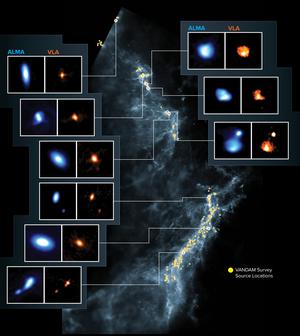Glossary term: 恒星形成
Description: 恒星的诞生源于巨型分子云中被称为核心的低温致密区域的引力坍缩,这些区域大多位于星系的旋臂中。恒星的形成涉及复杂的物理过程,发生在不同的尺度上,由引力、压力、辐射、磁场、湍流、化学等作用造成,其中有些作用至今仍不甚明了。根据母云的质量和形成阶段的吸积过程,恒星的质量从 0.08 到几百个太阳质量不等。大多数恒星都不是孤立形成的,而是恒星群的一部分。在形成阶段,中心恒星周围会形成一个原恒星盘,最终为行星的形成提供原材料。
Related Terms:
See this term in other languages
Term and definition status: The original definition of this term in English have been approved by a research astronomer and a teacher The translation of this term and its definition is still awaiting approval
The OAE Multilingual Glossary is a project of the IAU Office of Astronomy for Education (OAE) in collaboration with the IAU Office of Astronomy Outreach (OAO). The terms and definitions were chosen, written and reviewed by a collective effort from the OAE, the OAE Centers and Nodes, the OAE National Astronomy Education Coordinators (NAECs) and other volunteers. You can find a full list of credits here. All glossary terms and their definitions are released under a Creative Commons CC BY-4.0 license and should be credited to "IAU OAE".
If you notice a factual or translation error in this glossary term or definition then please get in touch.
Related Media
见证一颗恒星的诞生
Credit: ESO/ALMA (ESO/NAOJ/NRAO)/H.Arce. 致谢:Bo Reipurth credit link
License: CC-BY-3.0 Creative Commons Attribution 3.0 Unported icons
恒星诞生环境
Credit: ALMA (ESO/NAOJ/NRAO), J. Tobin; NRAO/AUI/NSF, S. Dagnello; Herschel/ESA credit link
License: CC-BY-3.0 Creative Commons Attribution 3.0 Unported icons










